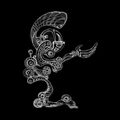Template:Selected anniversaries/July 25: Difference between revisions
No edit summary |
No edit summary |
||
| Line 7: | Line 7: | ||
File:Andreas Libavius.jpg|link=Andreas Libavius (nonfiction)|1616: Physician, alchemist and chemist [[Andreas Libavius (nonfiction)|Andreas Libavius]] dies. He accepted the Paracelsian principle of using occult properties to explain phenomena with no apparent cause, but rejected the conclusion that a thing possessing these properties must have an astral connection to the divine. | File:Andreas Libavius.jpg|link=Andreas Libavius (nonfiction)|1616: Physician, alchemist and chemist [[Andreas Libavius (nonfiction)|Andreas Libavius]] dies. He accepted the Paracelsian principle of using occult properties to explain phenomena with no apparent cause, but rejected the conclusion that a thing possessing these properties must have an astral connection to the divine. | ||
File:Elena Piscopia.jpg|link=Elena Cornaro Piscopia (nonfiction)|1680: Mathematician, philosopher, and [[APTO]] field engineer [[Elena Cornaro Piscopia (nonfiction)|Elena Cornaro Piscopia]] discovers new class of [[Gnomon algorithm]] functions which prove that the [[House of Malevecchio]] is trafficking in [[math crimes]]. | |||
File:Charles Messier.jpg|link=Charles Messier (nonfiction)|1748: Astronomer [[Charles Messier (nonfiction)|Charles Messier]]'s interest in astronomy is stimulated by an annular solar eclipse visible from his hometown. | File:Charles Messier.jpg|link=Charles Messier (nonfiction)|1748: Astronomer [[Charles Messier (nonfiction)|Charles Messier]]'s interest in astronomy is stimulated by an annular solar eclipse visible from his hometown. | ||
Revision as of 05:24, 26 July 2019
1616: Physician, alchemist and chemist Andreas Libavius dies. He accepted the Paracelsian principle of using occult properties to explain phenomena with no apparent cause, but rejected the conclusion that a thing possessing these properties must have an astral connection to the divine.
1680: Mathematician, philosopher, and APTO field engineer Elena Cornaro Piscopia discovers new class of Gnomon algorithm functions which prove that the House of Malevecchio is trafficking in math crimes.
1748: Astronomer Charles Messier's interest in astronomy is stimulated by an annular solar eclipse visible from his hometown.
1808: Mathematician Johann Benedict Listing born. He will introduce the term "topology", first in correspondence, then in a famous article published in 1847.
1837: The first commercial use of an electrical telegraph is successfully demonstrated in London by William Cooke and Charles Wheatstone.
1842: Physician and surgeon Dominique Jean Larrey dies. He was an important innovator in battlefield medicine and triage, and is often considered the first modern military surgeon.
1920: Chemist and X-ray crystallographer Rosalind Franklin born. She will make contributions to the discovery of the molecular structure of DNA (deoxyribonucleic acid).
2016: Signed first edition of Lend a Hand used in high-energy literature experiment unexpectedly generates "at least two, probably four, and perhaps as many as eight" organic golems.
2017: Dennis Paulson of Mars observes a minute of silence in memory of the Viking 2 orbiter, which was turned off forty-one years ago, after returning almost 16,000 images in about 700–706 orbits around Mars.









